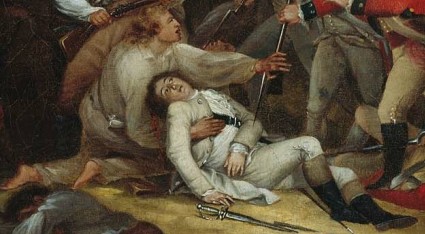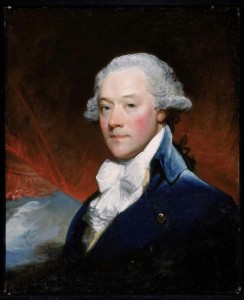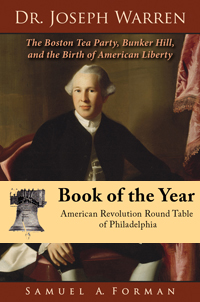Commentary: Recently Frederic C. “Rick” Detwiller called to my attention to his belief that James Swan (1754-1830) may well be a key, and heretofore unrecognized figure depicted in John Trumbull’s iconic painting of the Battle of Bunker Hill. In the central vignette of Trumbull’s painting a supine Joseph Warren stares upward at the moment of his battlefield martyrdom. A British soldier thrusts his bayonet toward the dying Warren, a lunge averted by two men. One is British Colonel Small, attempting to save Warren in a chivalric gesture. The other is a handsome young militiaman bravely warding off the intimidating and deadly bayonet with his bare hand. Behind him is Lieutenant Knowlton of Connecticut standing his ground against the onrush of British soldiers. For Warren it is too late. Close inspection reveals that he has suffered a fatal gunshot wound of the head. The protective gestures of both foe and friend will not extend the expiring Warren’s life another instant. While the figures of Warren, Small, and Knowlton have been long identified, the coat-less militiaman protecting the dying Warren has never been named. It is this brave young man in the painting that Mr. Detwiller believes is James Swan.
I had not encountered this assertion before, so I asked Rick to share his rationale in detail. As leader of the architectural and planning firm New England Landmarks (302 George Street, Georgetown, MA), Mr. Detwiller brings a canny and creative eye to a variety of sources in his researches on historic structures. He observes, “I tend to stumble upon these things doing historic structure reports when looking for information on the builders and mechanics of 18th century Boston, and their patrons. Always amazing what can turn up unexpectedly.” Rick is active on the board of the Shirley-Eustis House, an impressive place museum in Roxbury, Massachusetts. He first became interested in James Swan as the builder and owner of a nearby mansion erected in the 1790s. Unfortunately, that building no longer stands, but the curious legacy of James Swan persists for those who care to look.
Mr. Detwiller did not have time just now to write this blog as a guest. He kindly agreed that I do so, spelling out the fruits of his research and reasoning. This is the first of three entries, addressing sequentially: 1) the case for James Swan appearing in Trumbull’s Bunker Hill, 2) a sketch of James Swan’s peripatetic life, and finally 3) a closer look at John Trumbull’s approach to his Bunker’s Hill and whether or not that strengthens belief that Swan is the cryptic central figure.
The June 17, 1775, Battle of Bunker Hill, or Breed’s Hill for those compelled to geographic preciseness, commands our attention as the set-piece conflict of the early Revolutionary War. A litany of superlatives and circumstances support this contention. It was one of the largest battles of the war, resulted in an appalling number of casualties particularly of the British; involved combined amphibious and naval attack on a large scale; subsequently impacted much of British and American tactics during the rest of the conflict; was fought in plain sight of the populace of Boston; involved leading British generals Howe, Burgoyne, and Clinton on the field; and saw the death of charismatic Patriot Dr. Joseph Warren. John Trumbull chose this episode for the first of a life-long string of historical paintings, many of which remain as icons in American history. The battle has commanded attention of both historians and the general public, both in fiction and histories, down to our present day.
John Trumbull made it a point to include portraits of prominent figures in his historical paintings. Art historians note that he obtained them by sittings of the individuals, from other portraits, or from close relatives when the subjects had died. He painted Bunker’s Hill in the second part of 1785 and finished it by the spring of 1786. In the mid-1780s Trumbull was resident in London under the artistic tutelage of expatriate painter Benjamin West. By then, the peace between Britain and the young United States permitted Trumbull to strengthen his historical depictions with authoritative likenesses of British leaders and as well as Americans, and obtained them on both sides of the Atlantic.
No documentation survives, nor have assertions been made in print, that James Swan is Warren’s protector in Bunker’s Hill. Rick Detwiller has assembled interesting circumstantial evidence supporting the identification.
Gilbert Stuart’s 1795 portrait of James Swan, now on display at the Boston Museum of Fine Arts, is consistent with Trumbull’s handsome coat-less and shoeless young militiaman of 1775.
The high forehead, aquiline nose, and assertive presence comprise notable similarities. Rick will be the first to temper conclusions based only upon visual evidence. The paintings are by different artists and depict men at differing ages. James Swan’s hair in 1795 is gray – either powdered or prematurely so. The twenty years younger militiaman in Trumbull’s painting is strikingly blonde. Hair color does not help narrow the identification.
James Swan was a financial clerk in the Massachusetts Provincial government in 1775. It is very likely that Joseph Warren knew him personally from Warren’s overlapping roles as President pro tem of the Massachusetts Provincial Congress, and variously chairman or member of its Committees of Safety, Donations, and Supply. Swan may have been a member of St. Andrew’s Masonic Lodge, where Warren was Grand Master. A primary source documenting Swan’s role at that juncture is his August 8, 1775 notation concerning the first foreign military supplies, due to arrive from Cap François, St. Domingue. James Swan kept the Committee on Supplies’ accounts.
More specifically, James Swan participated in the Battle of Bunker Hill and is said to have accompanied Joseph Warren there. A primary source for Swan’s participation, apparently as a volunteer because he was not formally enrolled in a fighting unit, was his claim for personal equipment losses from the Battle of Bunker Hill, a claim including a damaged musket and a missing coat:
“James Swan wou’d inform the Committee, appointed by
the General Court of Massachusetts Bay, to take into
consideration & make allowances for the loss those
that were engaged in the Lexington & Bunker Hill fights
sustain’d, that he having gone on the 17th June to
Charlestown with Dr Warren as a Volunteer, got engag’d
the whole of the Battle, by which he lost a Coat,
allowing 1/3d wore, Value £2: 8: 0
& Got his Gun broke, which cost in mending—— 9: 4
£2:17: 4
Which sum he refers to the Comee to allow him
Or not. He never expected, nor meant to apply for a
reimbursement, but since the Court has been
Generous enough to offer it, he applies in common
with others Watertown, Treasurer’s Office
5 Jany 1776” (Transcribed by Frederic C. Detwiller, May 29, 2014.)
In those accounts Swan records about £6 paid to himself along with larger amounts to Joseph and James Warren, John Hancock, Paul Revere, Samuel Adams and other notable Patriots. This particular documentation seems unknown to Warren’s biographers and historians of Bunker Hill.
Francis Drake, a nineteenth century local historian asserted the Swan–Warren linkage:
“He [Swan] accompanied Warren as a volunteer aide to Bunker’s Hill and was wounded at his side….”
Earlier, in 1865, Warren biographer and chronicler of the Siege of Boston wrote:
“It is said that one of his [i.e. Warren’s] students, Dr. Townsend, accompanied him a part of the way on foot, but that, a short distance from the College, Warren was on horseback. He overtook two friends [footnoted as James Swan and James Winthrop] who were walking to the battle-field, and, exchanging with them the usual salutations, he passed along towards Charlestown.”
The usually meticulous Frothingham did not spell out his source, but it might have been Hazard’s United States Commercial and Statistical Register for July 1841:
“Major James Swan, and James Winthrop, Esq., accompanied him [i.e. Warren on the road to the Charlestown peninsula]; but not as aides – for he had none.”
We infer that James Swan was proud of his participation in the battle. He was part owner of the 1777 American seagoing privateer named Bunker Hill.
As for artist Trumbull knowing Swan, they had ample opportunities for interactions in the 1775-1777 time frame, and certainly knew one another late in the century. They had many friends in common. James Swan, as Provincial accountant in the provincial Treasurer’s office 1775-1776, likely met Trumbull when he was Washington’s aide-de-camp. In 1777 Thomas Dawes Jr. founded his club in Boston on Purchase Street of which Trumbull was a member along with William Eustis. Trumbull, then a novice painter, executed a “portrait of Thomas Dawes, head very respectable” as well as a design for a Palladian villa. Perhaps Trumbull sketched a now lost likeness of Swan in the 1775-1777 time frame, or perhaps this occurred in the 1780s in Europe. Both Trumbull and Swan may have interacted with one another in Paris when they separately interacted with Thomas Jefferson in 1788. A 1799 letter survives directly from James Swan to John Trumbull, a document at the least supporting their acquaintance.
Mr. Detwiller posits that Trumbull knew about the association of James Swan and Joseph Warren, accepted as true a version of the story of Swan as Warren’s impromptu aide on the battlefield, and depicted that association dramatically in Bunker’s Hill as Swan desperately warding off the bayonet thrust on the dying Warren.
In upcoming entries, enlivened by the input of J.L. Bell, we visit the life of James Swan, Trumbull’s approach to his painting Bunker’s Hill, and whether the weight of evidence identifies James Swan as the coat-less protector of the dying Warren.
Sources: John Trumbull Death of Major General Joseph Warren at the Battle of Bunker’s Hill, June 17, 1775 Yale University Art Gallery, New Haven, CT. Accession 1832.1.
Portrait of James Swan by Gilbert Stuart, 1795. Courtesy Boston Museum of Fine Arts
Entry for August 8, 1775, and Swan’s claim for losses at Bunker Hill. In: Massachusetts Provincial Accounts 1770-1776, Accounts of the Committee of Safety and Supplies. Boston: Massachusetts Archives, Vol. 255, microfilm reel 263, p. 822 James Swan re: Bunker Hill
Francis S. Drake The Town of Roxbury: Its Memorable Persons and Places, Its History and Antiquities: With Numerous Illustrations of Its Old Landmarks and Noted Personages. Roxbury: published by the author, 1878, p.137
Richard Frothingham The Life and Times of Joseph Warren Boston: Little, Brown, & Co., 1865, p. 513
James Swan to John Trumbull, letter dated November 22, 1799. Miscellaneous manuscripts, Boston: Massachusetts Historical Society. A letter written by James Swan, then in Hamburg, Germany to the United States commissioner to Great Britain in London, John Trumbull, regards family financial affairs.
Hazard, S., and W.F. Geddes. 1841. Hazard’s United States Commercial and Statistical Register, July 1841, Vol. 3, p. 30


 Follow
Follow